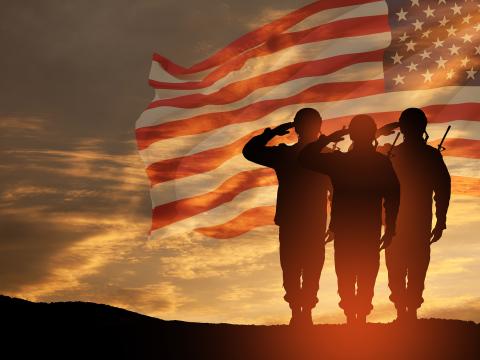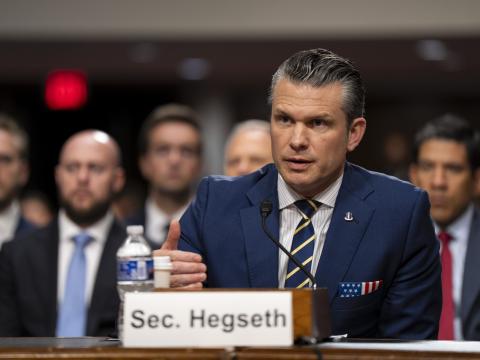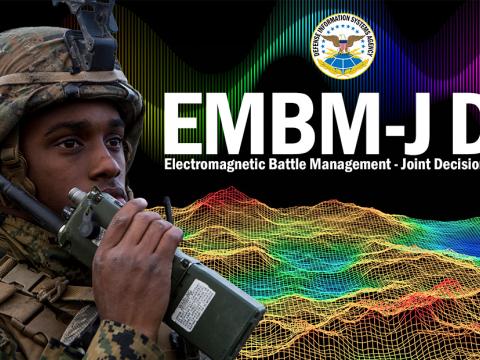Think Joint, Fight Joint, Train Joint
Services to prepare for future conflicts in global classroom.
The U.S. Defense Department is reconfiguring its training approach so service personnel can learn the same way as they will fight—in a joint environment. To ensure that this is achievable, the department is looking to the U.S. Joint Forces Command to provide active management of joint training systems and capabilities across the armed forces and across the nation.
Each of the services has a variety of courses that help personnel stay abreast of new technologies, concepts and tactics. However, the first time a sailor works with a soldier may be in the field. The Joint National Training Capability (JNTC), a new concept being crafted by the Defense Department and the Joint Forces Command (JFCOM), J-7, addresses this quandary. It is aimed at providing a global, integrated network of live-fire training ranges and a linked network of simulation capabilities as well as filling the gaps between service training processes and systems.
Greg Knapp, JNTC program manager at the command, explains that the capability has two primary goals. The first is to create a set of conditions that allows the military to configure its forces the way they fight. “If you ask if we do that in current training programs, the answer is by and large no,” he says.
Based on two years of study, the JNTC has determined national level needs. Current programs have been examined to ascertain how to help them to become more joint. “The thing that we’re trying to do on a national level and here at JFCOM is to fuse the programs so that we can get coherent joint training,” Knapp says.
The second objective supports the first, he offers. JFCOM must be a systems manager across the nation so that technologies are interoperable and support joint training requirements more efficiently. “We need to look at our national instrumentation, at some of our optical or simulation programs, communications infrastructure, computing infrastructure, all the supporting elements of training programs in a different way. We need to look at them from a national investment viewpoint, and JFCOM has to be the systems manager for this process,” Knapp offers.
The JNTC is not about a technical solution looking for a problem, he quickly adds. It is about understanding the warfighting problem first, then ensuring that the investments within the services and JFCOM match the operational requirements and that the command can manage the technology piece. “Now that’s different. If you look at the way we’ve done business in the past, we’ve not really invested in detailed joint requirements, and we haven’t invested in the overarching technology that we need to integrate at a national level to support the joint distributed training environment,” he explains.
Another critical part of the JNTC relates to the flow of knowledge. At the joint level, it should occur through the experimentation program, Knapp explains. Once working concepts are identified, data can be shared with the operational elements in the same environment. “When we tie together the DCEE [distributed continuous experimentation environment] to training community needs, there’s a lot of overlap. What we’re actively managing in cooperation with the J-9 is determining the common simulations, live and virtual aspects that we need to share. We want to get the two programs into the optimal position so we can have the same fidelity in training as we had in the initial experiments—without reinvesting,” Knapp says.
The technical elements of the JNTC program consist of the global joint training infrastructure and advanced training techniques. Several other components make up the operational side of the program, including a full-application joint training system, a permanent joint command and control element, and the permanent operational capability to create joint operational scenarios for training warfighters for conditions in the 21st century, Knapp explains.
The JNTC’s joint management office, which currently is JFCOM’s J-7, oversees these various elements and collects, merges and validates the national requirements for the program. Once finalized, the JNTC will use available best-of-breed technologies and will help the services arrange them in the best configuration, he offers.
The J-7’s goal is not experimentation but rather an operational program. “The JNTC is set up so that JFCOM is empowered to offer incentives to the services to bring capabilities to bear on our problems. Or, if a service has an instrumentation or different system that isn’t quite interoperable or isn’t quite up to speed with the other services, then we actually can work with those services to bring their systems up to standards,” Knapp explains.
“The JNTC is really an incentive-based program led by JFCOM to bring people up to a joint level. We’re spending more energy trying to map solutions that exist today to problems that exist today than trying to create a new technology,” he says. The joint management office and the JNTC will help the services develop a common road map so that the 2010 or 2020 instrumentation of the Navy, for example, will be interoperable or possibly interchangeable with U.S. Air Force equipment, he adds.
While the services are successfully ensuring that their own systems are interoperable, Knapp points out that the relative newness of the joint operations environment requires comparable work for the joint environment.
The DCEE, operating under the auspices of JFCOM’s experimentation directorate (J-9), will support the JNTC. The initial group moved into its own space last month, albeit in trailers. The goal is to re-create a portion of the experimentation environment used in MILLENNIUM CHALLENGE 2002 (SIGNAL, November 2002, page 49), which featured interactive live and virtual forces. Ultimately, the DCEE will consist of extensive modeling simulations, federations, software and networks joined into one common computer infrastructure that will feed training events and experiments.
Through the DCEE, combatant commanders will be able to participate in experiments and exercises from their headquarters locations. The permanent capability will include quantitative and qualitative analysis, flexible plug-and-play standards and the opportunity for diverse organizations to participate in experiments, including industry, multinational and service partners.
Greg Johnson, assistant J-9 for prototyping, JFCOM, explains that the DCEE is about breaking paradigms. In the past, the approach was to conduct a small number of large experiments. Because the J-9 did not have its own facility, it had to find and negotiate for space for the events, he explains.
“We would go into these facilities, and the kinds of experiments and the kinds of C4I [command, control, communications, computers and intelligence] systems we installed required us to rebuild the facility completely from the ground up. We would put in networks underneath the floors, installing all this experimental C4I equipment and doing whatever testing we could because of the short period of time that we owned the facility. And then we’d go into the event. We’d run the event. We’d cross our fingers that everything worked right—and generally it did—but when the event was done, we tore everything up, packed it all up, went away and started planning for the next event,” Johnson says.
This approach is hard on both the equipment and personnel, but more importantly it limits experimentation opportunities, he asserts. Creation of the DCEE changes this model and will allow the J-9 to conduct experiments more often, possibly as frequently as every 90 days, rather than once or twice a year.
The DCEE will support a variety of joint mission types, from futuristic logistics in space to realistic street fighting in urban operations. Because designated personnel staff the facility, the DCEE will both support examination of future joint operational concepts and expedite operational recommendations based on experimental insights.
“We can turn around these ideas very quickly. If we go into an event one week and find something very interesting, within two or three weeks we can do another event to really explore what we found in the first case. So that’s what the DCEE is all about, being able to do lots of small events, turn ideas very quickly and then refine those ideas so we can get them to the point where we can go into operationalizing them,” Johnson says.
The concept prototyping process involves a form of spiral development. The ideas are taken to a specific point, at which time they are turned over to the warfighter to examine. Feedback from warfighters is woven into the original concept, then the revised version is turned over to another command for refinement, Johnson explains. “It is a very symbiotic relationship,” he says.
A variety of activities will take place within the DCEE building, including workshops, war games and human-in-the-loop limited objective experiments. J-9 personnel and experts will support these events.
Annette C. Ratzenberger, chief, experimentation engineering department, J-9, JFCOM, explains that DCEE staff members are working closely with JNTC personnel to determine common requirements and objectives. The DCEE and JNTC will be using the same simulation tools; however, they may not be configured in the same manner. “In some cases, they will federate with models A, B and C, and we’ll federate with A, B and D, for example. It will depend on the requirement at the time for what we’re doing as well as for what they’re doing,” she says.
Although the DCEE and JNTC connection is not physical, they do fit together in terms of tools, databases and people. The command will spend money for the tools once, so the two are not going off on separate paths, Ratzenberger explains. Service organizations will turn to the DCEE for simulations and to the JNTC for training, she adds.
The same team is developing the federation. “So we know that there will be consistency and commonality in the two. The data sets in some cases are the same—same terrain data, same weather data—but what will be different will probably be the time frames. JNTC, because it is training-focused, will use today’s weapons systems, force structures and doctrines. We’ll always be out front using multiple time frames. We’ll be dealing with 2007, 2010, 2015, 2020. Our data will be different in terms of the capabilities that we’re examining,” she explains.
C4I links will be the same for both the JNTC and DCEE; however, the DCEE’s will change when it moves into the experimental C4I arena. “As the C4I devices are evolving from message-based traffic to more Web-based applications, the linkages between our simulations and our C4I devices must evolve as well,” she says.
Both the JNTC and the DCEE will be connected to all of the major simulation sites and major ranges, Ratzenberger states. The JNTC will link with the service simulation sites and training ranges. On the experimentation side, DCEE needs to link with the service simulation sites and the service battle labs. The only time DCEE will link with the training sites will be during a large experiment such as millennium challenge 2002. “But this time the infrastructure will be there and will have been used through the JNTC. So we think this is a win-win situation, particularly if we have to do anything like millennium challenge 2002 that involves a live-simulation mix,” she relates.
Initially, the permanent facility will house only the DCEE. After the first three months, however, Johnson believes that the J-9 will want to connect to other networks that will allow DCEE to link to various service agencies—for example, war colleges, service simulation centers, battle labs and combatant commanders sites. As a result, the services and combatant commands can participate in experiments without traveling to a specific site. Multiple participant work may take place as early as this summer, Johnson says.
Some spiral testing of services and multinational connectivity will take place early this month, and the first distributed test is scheduled for this summer. Simulation traffic will be distributed to Germany, Canada and Australia. Similar work took place earlier this year during an operational net assessment limited objective experiment with Canada, the United Kingdom, Germany and Australia.
The DCEE building is scheduled to be completed in two years, but the J-9 did not want to wait for a permanent facility to begin its work, Johnson relates. “We can’t wait any longer; we’ve waited long enough,” Johnson says. Even after the building is complete, Ratzenberger predicts that trailers will still be needed to support the various J-9 projects and programs.
The J-9 does not work with designated companies, and it is interested in various types of technologies. Decision-support, situational awareness and search tools are among the commercial capabilities the J-9 uses in experiments to determine their effectiveness for the warfighter.
Collaborative tools are used extensively by the organization now and have reduced meeting times significantly. Earlier this year, one multinational limited objective experiment was organized almost exclusively using these tools and the Internet, Johnson notes.
Knapp says that information technology specialists are key to the success of both the DCEE and the JNTC. “A big part of this program is setting up a national communications infrastructure, and we have challenged our J-6 community to improve dramatically the way they’re providing the communications services for our training programs. In other words, today we have set up our communications services to be done on a bit-by-bit basis. We set it up; we pay for it; we tear it down. The cost in logistics in doing that is really taking away from our training programs. We’d like to see an order of magnitude increase in our telecommunications efficiency overall. We’d like to see a permanent, persistent capability that we can access immediately,” he says.




Comments